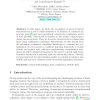Free Online Productivity Tools
i2Speak
i2Symbol
i2OCR
iTex2Img
iWeb2Print
iWeb2Shot
i2Type
iPdf2Split
iPdf2Merge
i2Bopomofo
i2Arabic
i2Style
i2Image
i2PDF
iLatex2Rtf
Sci2ools
IPMI
2009
Springer
2009
Springer
Joint Bayesian Cortical Sulci Recognition and Spatial Normalization
In this paper, we study the recognition of about 60 sulcal structures over a new T1 MRI database of 62 subjects. It continues our previous work [7] and more specifically extends the localization model of sulci (SPAM). This model is sensitive to the chosen common space during the group study. Thus, we focus the current work on refining this space using registration techniques. Nevertheless, we also benefit from the sulcuswise localization variability knowledge to constrain the normalization. So, we propose a consistent Bayesian framework to jointly identify and register sulci, with two complementary normalization techniques and their detailed integration in the model: a global rigid transformation followed by a piecewise rigid-one, sulcus after sulcus. Thereby, we have improved the sulci labeling quality to a global recognition rate of 86%, and moreover obtained a basic but robust registration technique.
Complementary Normalization Techniques | Global Recognition Rate | IPMI 2009 | Localization Variability Knowledge | Medical Imaging |
| Added | 17 Nov 2009 |
| Updated | 17 Nov 2009 |
| Type | Conference |
| Year | 2009 |
| Where | IPMI |
| Authors | Matthieu Perrot, Denis Rivière, Alan Tucholka, Jean-Francois Mangin |
Comments (0)

